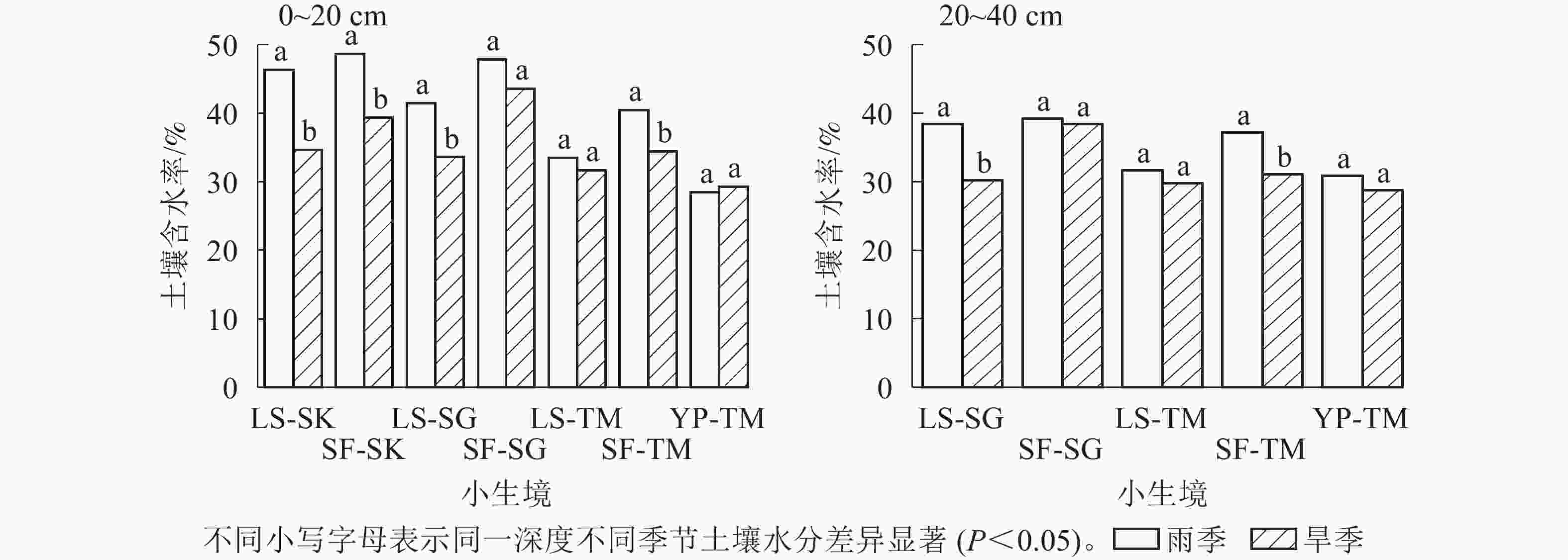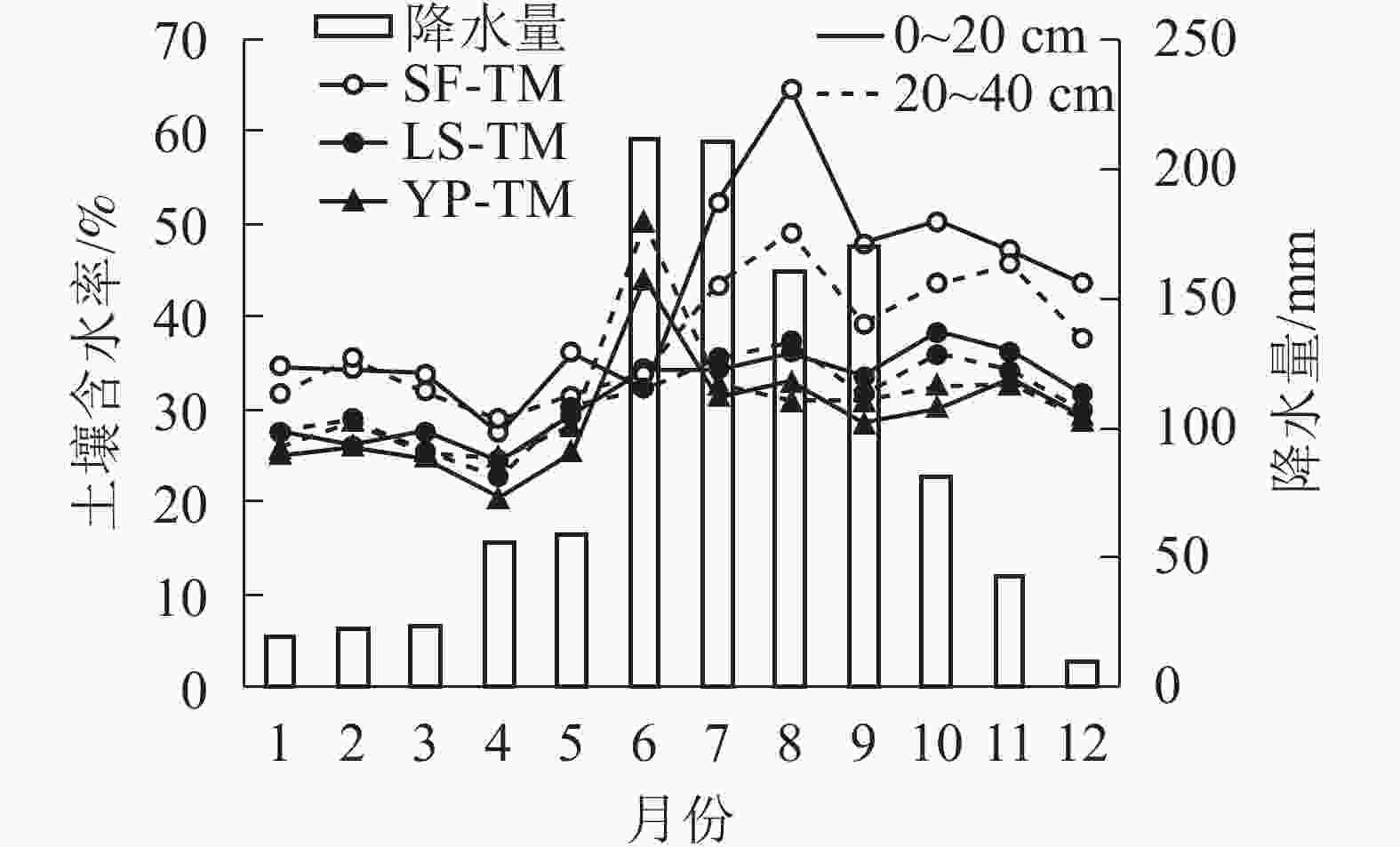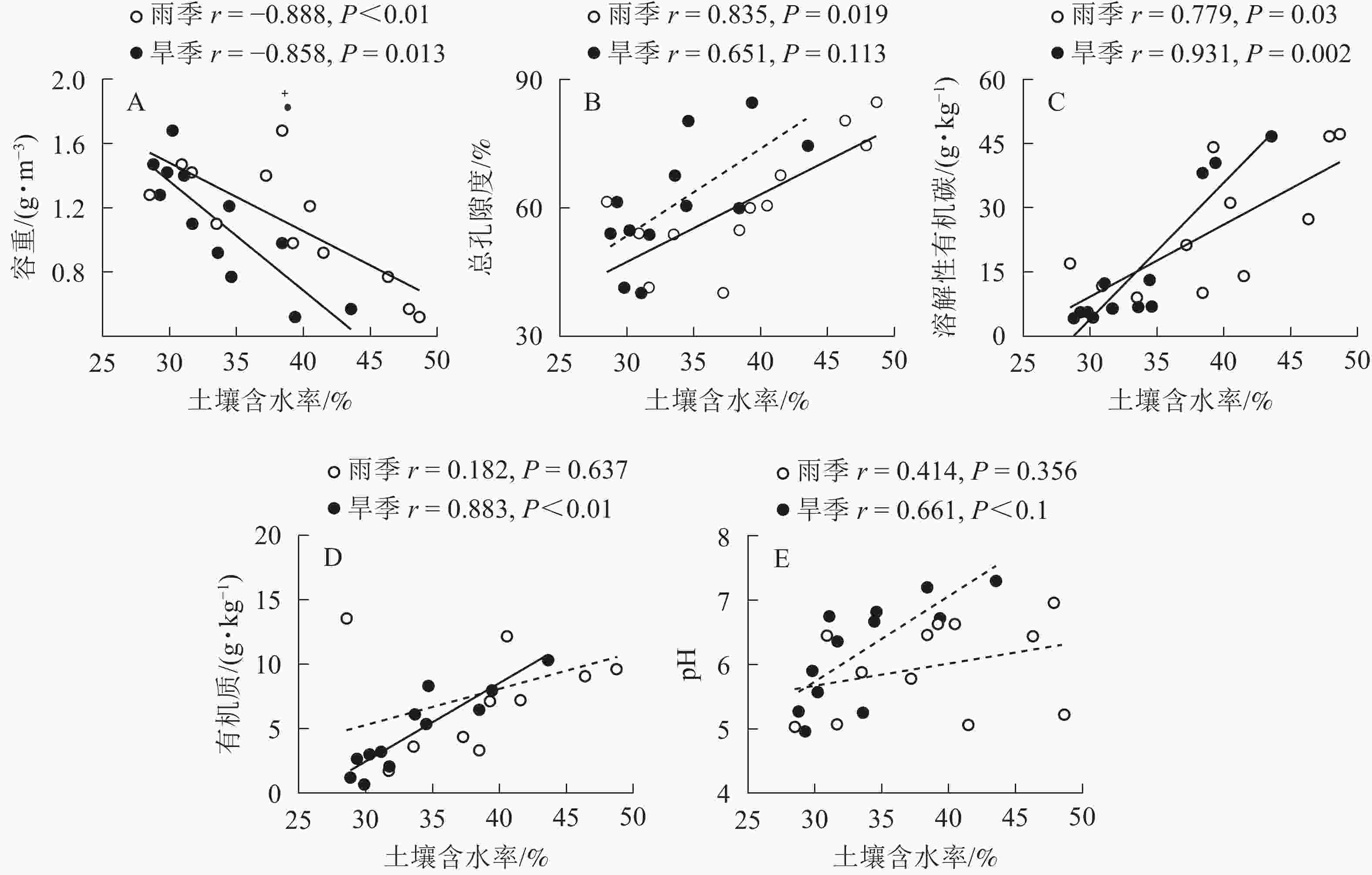-
土壤水分是喀斯特生态系统结构、功能、多样性的主要控制因子[1-2],决定和影响着生态系统的修复与稳定,是石漠化治理的关键[3]。在喀斯特地区的土层薄和分布不连续、水力传导率高、地表地下的二元结构、地表水漏失导致了土壤的储水能力低,因此,土壤水分依旧是喀斯特生态系统恢复的关键因子[4-5]。随着植被的恢复,土壤有机质和孔隙度增加、容重减少、有效提升了土壤水分的含量[6-7],遏制了石漠化的发展。在重度石漠化地区,受到地质地貌的影响,小生境发育类型多样,有石面、石坑、石沟、土面等小生境,使得地表出露的岩石和土壤分布具有非均匀性。同时,小生境因水分、热量等环境因子的不同使得小生境土壤水分具有差异性[8-9],这为生态系统的恢复和重建增加了难度。对喀斯特土壤水分的研究发现:不同植被群落的土壤水分有季节和空间差异,地形和微地貌、植被类型是其分布差异的主要影响因素[10-12],对微地貌的研究发现石沟的土壤水分状况优于土面[13-14]。滇东喀斯特地区石漠化分布集中、程度深,自北向南逐渐增多、程度加重[15]的特点。土壤侵蚀严重,小生境发育多样,石漠化严重的地区植被退化为石灰岩灌丛。在退化迹地上自然演替发育清香木Pistacia weinmannifolia次生林,以及人工播种恢复的云南松Pinus yunnanensis人工林2种不同的植被模式。本研究选择人工和自然植被恢复群落下的小生境,探讨小生境土壤水分与植被恢复的关系,分析小生境的土壤水分差异性及影响因素,为滇东高原石漠化的恢复治理及小生境的合理利用提供科学参考。
-
滇东南普者黑峰林湖盆区(23°45′~24°28′N,103°34′~104°45′E)位于云南高原的东南缘,总体地势向东南倾斜,主要地貌特征为峰丛盆(洼)谷地组合形态,岩溶发育强烈不均匀,地下水深埋[15]。气候为中亚热带高原季风气候区,多年平均气温为13.7~18.6 ℃,11至翌年4月为旱季,5−10月为雨季,旱季平均气温为11.6 ℃,雨季平均气温为24 ℃,多年平均年降水量为969~1 566 mm。
在普者黑峰林湖盆区中部的菜花箐小流域(24°7′52″N,104°6′11″E)建立研究观测样地。地带性植被为半湿性亚热带常绿阔叶林,目前已被破坏殆尽,退化迹地上存留石灰岩灌丛,以及20世纪80年代以来人工种植的云南松纯林和自然恢复的清香木次生林。根据植被群落调查,人工种植的云南松纯林和自然恢复的清香木次生林均为成熟林阶段,因此,选择坡位坡度相似的石灰岩灌丛(limestone shrub, LS)、清香木次生林(secondary forest, SF)、云南松人工林(Yunnan pine plantation, YP)作为研究样地(表1)。
表 1 样地基本情况
Table 1. Condition of surveyed plots
植被类型 坡度/(°) 坡向 基岩裸露率/% 乔木层盖度/% 灌木层盖度/% 草本层盖度/% 凋落物厚度/cm 凋落物存量/(t·hm−2) 清香木次生林SF 30 SW 79 94 12 10 3.0 10.28 石灰岩灌丛LS 22 SW 87 11 75 48 1.1 1.62 云南松人工林YP 24 N 5 78 10 11 0.8 14.96 -
采用野外调查和实验相结合的方法,在5 m×20 m的样方内对不同植被群落的小生境和群落结构进行调查(表2)。石面(出露基岩的岩石,SM)无土壤或有少量苔藓;石沟(构造线状的廊道,SG)宽0.6~5.0 m,长1~300 m,土壤较多,土多石少,土石比≥70%;石坑(基岩上发育的溶蚀凹地,SK)土石比≥40%;土面(近圆状溶坑发育而来,TM)直径≥0.3 m,深度较大,土层厚度较厚,土石比≥80%。
表 2 样地小生境基本情况
Table 2. Basic information of the sample niches
植被类型 各小生境比例/% 土层厚度/cm 封禁时间/a 石面SM 石坑SK 石沟SG 土面TM 清香木次生林SF 72.44 6.23 4.08 17.25 0~80 50 石灰岩灌丛LS 77.32 5.62 15.40 1.76 0~50 16 云南松人工林YP 8.33 0 0 91.67 0~100 36 于2015年1−12月对小生境土壤进行采样,石面无土壤,主要对石坑、石沟、土面小生境的土壤进行采样,石坑土层薄,在0~20 cm采样,其余在0~20、20~40 cm进行采样,选取3~5个点的土壤混合后自封袋密封带回实验室,测定土壤含水率、土壤容重、总孔隙度、溶解性有机碳、pH、土壤有机质6个指标。土壤含水率采用烘干法,容重和总空孔隙度采用环刀法,溶解性有机碳采用有机质光度法,pH采用酸度计法,有机质采用重铬酸钾容量法,其中土壤含水率、容重和总孔隙度、pH由实验室分析完成,溶解性有机碳、土壤有机质由云南省农业科学院分析中心完成。
-
运用Excel 2010对数据进行预处理,再结合SPASS 22.0 进行Pearson相关性分析,用Grapher 9进行绘图。
-
由图1可见:不同植被下小生境的土壤含水率为28.50%~48.67%,0~20 cm的小生境土壤含水率高于30~40 cm,除云南松人工林土面的土壤含水率随土层深度的增加而增加之外,其他植被下小生境的土壤含水率随土层深度的增加而减少。土壤水分季节性差异明显,雨季的石坑、石沟、土面的土壤含水率分别比旱季增加了28.72%、16.71%和7.79%。0~20 cm各小生境土壤含水率的季节性变化大,而20~40 cm各小生境土壤含水率季节变化幅度小。其中,20~40 cm清香木次生林石沟和土面的土壤水分在旱季和雨季处于稳定状态。

图 1 雨季和旱季不同植被下小生境的土壤含水率
Figure 1. Soil moisture contents of different vegetation communities in wet and dry seasons
同一植被下石坑、石沟、土面的土壤含水率不同,随着土层深度的增加而减少。旱季,土壤含水率从高到低依次为石沟(43.56%)、石坑(36.99%)、土面(31.80%);雨季,土壤含水率从高到低依次为石坑(47.495%)、石沟(44.69%)、土面(34.16%);平均土壤含水率从高到低依次为石沟(42.24%)、石坑(41.63%)、土面(32.98%)。同种小生境在不同的植被群落下土壤含水率不同,从高到低依次为清香木次生林(35.80%)、云南松人工林(31.67%)、石灰岩灌丛(29.36%),自然恢复的清香木次生林土壤含水率高于云南松人工林,自然恢复优于人工恢复。随着植被的恢复,小生境的土壤水分增加,同一植被群落下不同小生境之间的土壤水分差异性减少,人工和自然恢复相比,自然恢复的清香木次生林中小生境土壤水分的差异性减少高于人工恢复的云南松人工林,小生境土壤水分趋于均一性。
不同植被下土面小生境的土壤含水率与降水量进行分析(图2)发现:雨季土面的土壤含水率明显增加。不同深度的土壤水分变化不同,在0~20 cm土面的土壤水分变化大,20~40 cm土面的土壤水分变化小。随着土层深度的增加,小生境的土壤水分更趋于稳定,旱季雨季变化小。不同植被群落土面生境的土壤水分变化不同,在云南松人工林的土面土壤水分更稳定,季节性差异小。清香木次生林中土面土壤水分季节性变化大,随着降水而迅速增加,雨季之后又快速减少。
-
由图3A显示:小生境的土壤容重为0.52~1.47 g·m−3,20~40 cm小生境的土壤容重高于0~20 cm,随土层深度的增加而增加,表层土壤的通气、蓄持水优于深层土壤。小生境的土壤容重从高到低依次为土面(1.26 g·m−3)、石沟(0.75 g·m−3)、石坑(0.65 g·m−3)。其中,土面在不同植被下的土壤容重从高到低依次为为石灰岩灌丛(1.41 g·m−3)、云南松人工林(1.38 g·m−3)、清香木次生林(1.29 g·m−3);石沟和石坑在石灰岩灌丛的土壤容重为1.04 g·m−3,清香木次生林中0.65 g·m−3,发现清香木次生林的土壤更疏松,土壤通气、蓄水性高于云南松人工林。
-
由图3B可见:小生境中土壤总孔隙度为53.75%~84.61%,0~20 cm的土壤总孔隙度高于20~40 cm,随着土层深度的增加总孔隙度减少。土壤总孔隙度从高到低依次为石坑(82.46%)、石沟(71.04%)、土面(51.75%);不同植被的土面生境中,土壤总孔隙度从低到高依次为石灰岩灌丛(45.56%)、清香木次生林(52.79%)、云南松人工林(57.69%);石沟和石坑小生境的土壤总孔隙度为石灰岩灌丛70.73%,清香木次生林75.92%。总之,不同小生境的土壤容重20~40 cm高于0~20 cm,土壤总孔隙度0~20 cm高于20~40 cm,说明表层土壤更疏松,孔隙度大,土壤的通气性和蓄持水能力更好。
-
由图3C可见:小生境土壤pH为4.96~7.30,土壤偏酸性,随着土层深度的增加而略微降低,20~40 cm的土壤pH略低于0~20 cm,土层越深小生境的土壤越趋于酸性或者弱酸性。除石坑土壤的pH雨季比旱季增加了0.96之外,土壤pH的季节性差异小。土面在不同植被中土壤pH从低到高依次为云南松人工林(5.42)、石灰岩灌丛(5.80)、清香木次生林(6.46);石沟和石坑小生境在不同植被中土壤pH为石灰岩灌丛6.10,清香木次生林6.52。随着植被的自然和人工恢复,土壤更趋于弱酸性和中性。
-
由图3D显示:小生境中溶解性有机碳质量分数为4.2~46.65 g·kg−1,20~40 cm的小生境土壤溶解性有机碳质量分数小于0~20 cm,随土层深度的增加而减少。雨季石坑、石沟、土面小生境分别比旱季增加了57.17%、13.56%、126.64%。小生境中溶解性有机碳质量分数从高到低依次为石坑(30.48 g·kg−1)、石沟(28.54 g·kg−1)、土面(13.73 g·kg−1)。土面在不同植被中土壤溶解性有机碳质量分数从低到高依次为石灰岩灌丛(6.92 g·kg−1)、云南松人工林(9.64 g·kg−1)、清香木次生林(19.49 g·kg−1);石沟和石坑在不同植被中土壤溶解性有机碳质量分数为石灰岩灌丛12.99 g·kg−1,清香木次生林43.84 g·kg−1。
-
由图3E可见:小生境土壤有机质质量分数为0.67~15.98 g·kg−1,20~40 cm的小生境土壤有机质质量分数低于表层,随土层深度的增加而减少。季节性差异明显,雨季平均增加了82.2%。石沟和石坑土壤的有机质质量分数高于土面,其中石沟土壤最高。石灰岩灌丛中土壤有机质质量分数从高到低依次为石坑(8.70 g·kg−1)、石沟(6.67 g·kg−1)、土面(2.84 g·kg−1);清香木次生林中从高到低依次为石沟(13.15 g·kg−1)、石坑(8.80 g·kg-1)、土面(8.76 g·kg−1)。土面在不同植被中土壤有机质质量分数从低到高依次为石灰岩灌丛(2.20 g·kg−1)、云南松人工林(5.69 g·kg−1)、清香木次生林(6.28 g·kg−1);石沟和石坑土壤有机质质量分数为石灰岩灌丛6.80 g·kg−1,清香木次生林(9.38 g·kg−1)。总之,随着植被的自然和人工恢复,小生境土壤pH、溶解性有机碳、有机质质量分数增加,自然恢复下小生境的土壤化学性质比人工恢复的云南松人工林好。小生境的表层土壤高于深层土壤,可能由于表层枯落物的分解,使得土壤的有机质、溶解性有机碳质量分数高,中和了土壤的pH,使得表层土壤更趋于中性和弱酸性。
-
在旱季和雨季的0~20、20~40 cm小生境土壤容重、总孔隙度、有机质质量分数、溶解性有机碳质量分数、pH与土壤含水率进行Pearson相关性分析(图4)发现:土壤水分与土壤性质具有明显的相关性。旱季的土壤容重与土壤含水率负显著相关(P<0.05),溶解性有机碳质量分数与土壤含水率极显著相关(P<0.01),有机质质量分数与土壤含水率极显著相关(P<0.01);雨季土壤容重与土壤含水率极显著负相关(P<0.01),总孔隙度与土壤含水率显著相关(P<0.05),溶解性有机碳质量分数与土壤含水率显著正相关(P<0.05),雨季和旱季土壤pH与土壤含水率相关不显著,不作为主要分析的土壤性质。综合分析发现:土壤容重、总孔隙度、溶解性有机碳和有机质与土壤水分有较强的相关性,是影响土壤水分的主要因子。
-
小生境微地貌不同对土壤水分的接受、储存、蒸发等有较大的差异[9],对植物分布、生长、发育的制约程度不同,使不同植物种类分别占领与其特性相应的小生境[13]。石坑和石沟生境相对封闭,石面和土面生境相对开放,雨季和旱季小生境土壤含水率从高到低依次为石沟、石坑、土面。这是由于石沟土壤体积小,植被覆盖高,减少了日晒,防止了土壤水分蒸发,此外,四周的水分往石沟、石缝里渗透,因而石沟能保持较高的含水量[16]。在石坑小生境中,枯落物堆积,土壤水分不易下渗,能够较好地保留在石坑中,但石坑土壤土层薄,不利于植物的生长,因此植被更倾向选择生境条件优越的石沟小生境。土面土壤位于下坡位,土层厚,土壤水分容易流失,随着降水的增加表层的土壤水分变化小。小生境的微地貌影响了土壤的水分,生境条件优越的石沟和石坑生境的土壤水分高于土面生境。同时,植物根系多穿梭于岩层裂隙而较少集中分布于土面[17],乡土植物种子退化后易遗留在石沟和石坑中,易萌发。旱季,清香木次生林石沟的土壤水分高于石坑,这是由于旱季降水少,石沟土层比石坑厚,狭窄的形状土壤水分不易蒸发。因此,石沟小生境在土壤水分缺少的旱季更具有优势,易储存和汇集水分,利于植被的生长。
-
土壤性质的不同导致了土壤水分储量、有效性不同,进一步影响到植物的分布和生长[18]。土壤含水量与容重、孔隙度关系密切[19],土壤容重越小,土壤的蓄持水的能力越强;土壤孔隙的组成影响土壤通气透水性[20],孔隙越多能容纳的水分越多[21]。土壤有机质作为土壤中的亲水物质,不仅可以吸持水分,增加土壤的水分含量,还能改良土壤结构,增加土壤的持水能力[22]。土壤水分状况能够在很大程度上影响溶解性有机碳的降解,土壤湿润时,微生物的代谢强度高,溶解性有机碳增加[23]。土壤容重、总孔隙度、溶解性有机碳、有机质是影响小生境土壤水分的主要因子。本研究发现:小生境的土壤容重总孔隙度、溶解性有机碳质量分数均从高到低依次为土面、石沟、石坑,有机质质量分数从高到低依次为石沟、石坑、土面,小生境的土壤含水率从高到低依次为石沟、石坑、土面,与以上规律基本一致。
本研究发现:小生境土壤的容重随土层深度的增加而增加,总孔隙度随着土层深度的增加而减少,溶解性有机碳和有机质随着土层深度的增加而减少,土壤水分则随着土层深度的增加而减少,表明表层土壤比深层土壤疏松和孔隙多,能够容纳更多的土壤水分,植物更易于获得土壤水分。不同土层的土壤溶解性有机碳和有机质质量分数不同,0~20 cm土层中更丰富。土壤容重、总孔隙度、有机质和溶解性有机碳的增加能够促进土壤大团聚体的形成。土壤优先流是土壤内部水分运动的常见形式,受到容重、总孔隙度、有机质的影响,使得优先流的发生在不同土层深度之间不同[24-25]。清香木次生林和云南松人工林中是大孔隙流,但在土坡坡积物土壤中的优先流类型是指流,表层和深层的流动速度和面积不同,造成了小生境土壤水分垂直方向上的差异。因此,土壤性质和优先流是土壤水分不同层次差异的主要因子。
同种小生境在不同的植被下土壤含水率不同,土壤性质的差异导致了土壤含水率的差异。自然和人工恢复植被使小生境土壤容重减少,孔隙度增加,改善了土壤的物理性质,使得土壤结构疏松、土壤的蓄持水能力增加。小生境的溶解性有机碳和有机质提高,促进土壤的保肥能力与供肥能力提高,增强了土壤团粒结构的形成,改善土壤的透水性、蓄水能力及通气性[26],使得土壤水分增加。同时,小生境的土壤水分增加和土壤改良又反过来促进了植被的生长,植被恢复与小生境土壤水分之间存在着反馈机制,并且自然恢复的清香木次生林的生态效益高于人工恢复的云南松人工林。
-
植被盖度从大到小依次为清香木次生林的乔木层(94%)、云南松成熟人工林(78%)、石灰岩灌丛(11%)。清香木次生林盖度大,土壤水分蒸发量少,林下环境相对湿润,而石灰岩灌丛盖度小,土壤水分蒸发量大,生境相对干燥。在清香木次生林中,乔木树冠对降水的截流作用,使得水分慢慢渗入土层,降低了地表径流[7]。云南松人工林的树冠截流作用低于清香木次生林,因此,在清香木次生林中小生境土壤含水率高于云南松人工林。
喀斯特地区土层薄,枯枝落叶层具有持水和截留能力[20],在涵养水源的方面发挥着重要作用[27-28]。石灰岩灌丛、云南松人工林、清香木天然次生中枯落物分别比石灰岩灌丛增加了9.2和6.3倍。枯落物厚度不同,从高到低依次为清香木次生林(3.0 cm)、石灰岩灌丛(1.1 cm)、云南松人工林(0.8 cm)。清香木次生林下凋落物含量最高,厚度大,更好地保持土壤水分,凋落物的蓄积和分解改善了小生境土壤的结构,增加了土壤的蓄持水能力,提高了土壤水分。
成熟林阶段的植被吸水根系的分布范围与土壤水峰值范围变化一致,表明喀斯特植被可能通过深根系的水力提升作用,获得深层土壤水和表层岩溶带地下水的稳定补给,促进土壤水分的再分配。清香木次生林是退化迹地上自然发育而来,以乡土树种混交为主,而人工播种的云南松人工林的树种单一。清香木粗根系的水力提升作用满足了旱季对土壤水分的需求,减少与伴生树种的水分竞争,保证了群落的稳定性。但云南松纯林植物水分利用来源相同,形成水分利用的竞争关系,不利于植物更新。因此,云南松需要与乡土优势树种等深根系植物混交,借助深根系植物的水分再分配作用来满足其自身生长对水分的需求。总之,小生境土壤水分的差异性与植被的恢复具有正向的协同性,随着植被的恢复,小生境的土壤水分差异性减少。
在滇东喀斯特石漠化的治理中,应该结合植被群落与小生境来进行植被恢复。在石灰岩灌丛早期的植被恢复可以利用石坑小生境;植被恢复的中期要发挥石沟小生境的优势;云南松林往往位于下坡位,可以结合乡土树种,混交树种优于单一树种,自然和人工恢复相结合。
Differences and influencing factors of soil moisture in karst microhabitats in southeast Yunnan
-
摘要:
目的 土壤水分是喀斯特石漠化地区植被恢复的关键因子,分析滇东南喀斯特小生境土壤水分差异性及其影响因素,可为喀斯特生态系统的恢复提供科学依据。 方法 以滇东南普者黑峰林湖盆区为研究区,选取石灰岩灌丛、清香木Pistacia weinmannifolia次生林、云南松Pinus yunnanensis人工林下的不同小生境(石沟、石坑、土面)为研究对象,分析小生境土壤水分的差异性及影响因素。 结果 ①各小生境的土壤水分季节性差异显著(P<0.05),平均土壤含水率从高到低依次为石沟(42.24%)、石坑(41.63%)、土面(32.98%),并随着土层深度的增加而减少。②石灰岩灌丛进行自然和人工恢复后,小生境的土壤含水率增加,从高到低依次为清香木次生林(35.80%)、云南松人工林(31.67%)、石灰岩灌丛(29.36%),自然恢复优于人工恢复。③小生境土壤水分差异性受到生境类型、土壤性质、植被群落的影响,植被往往优先选择生境条件优越的石坑和石沟小生境。不同土层深度的小生境土壤水分差异性受到土壤性质和土壤优先流的影响。 结论 喀斯特石漠化地区进行植被恢复要结合植被群落和小生境类型,优先选择石沟和石坑小生境,自然和人工恢复相结合,以促进喀斯特生态系统的恢复和改善。图4表2参28 Abstract:Objective This study aims to analyze differences in soil moisture and influencing factors of karst microhabitats of the eastern Yunnan Plateau, so as to provide scientific basis for the restoration of karst ecosystems. Method We studied karst niches (stone ditch, stone pit, soil surface) with different vegetation types, including limestone shrub, Pistacia weinmannifolia secondary forest and Pinus yunnanensis artificial mature forest under the forest-lake basin of Puzhehei karst. Result (1) In each niche soil moisture was significantly higher in the rainy season than in the dry season(P<0.05), and the order of average soil moisture was stone ditch (42.24%)>stone pit (41.63%)>soil surface (32.98%). (2) With natural and artificial restoration of limestone shrub, soil moisture increased from natural secondary forest over Pinus yunnanensis plantation to limestone shrub. Pistacia weinmannifolia secondary forest (35.80%)>Pinus yunnanensis artificial mature forest (31.67%)>limestone shrub (29.36%). (3) The difference in soil moisture in karst niches was influenced by the type of habitats, soil properties and vegetation type. Vegetation often preferred the karst niches of stone pit and stone ditch with superior habitat conditions. Conclusion Vegetation restoration in karst rocky desertification areas should be combined with vegetation communities and niche types, and stone ditch and stone pit niches should be given priority to vegetation restoration. The combination of natural restoration and artificial restoration can effectively improve karst ecosystems. [Ch, 4 fig. 2 tab. 28 ref.] -
Key words:
- soil science /
- karst /
- microhabitat /
- soil moisture /
- vegetation pattern /
- southeast Yunnan peak forest-lake basin
-
表 1 样地基本情况
Table 1. Condition of surveyed plots
植被类型 坡度/(°) 坡向 基岩裸露率/% 乔木层盖度/% 灌木层盖度/% 草本层盖度/% 凋落物厚度/cm 凋落物存量/(t·hm−2) 清香木次生林SF 30 SW 79 94 12 10 3.0 10.28 石灰岩灌丛LS 22 SW 87 11 75 48 1.1 1.62 云南松人工林YP 24 N 5 78 10 11 0.8 14.96 表 2 样地小生境基本情况
Table 2. Basic information of the sample niches
植被类型 各小生境比例/% 土层厚度/cm 封禁时间/a 石面SM 石坑SK 石沟SG 土面TM 清香木次生林SF 72.44 6.23 4.08 17.25 0~80 50 石灰岩灌丛LS 77.32 5.62 15.40 1.76 0~50 16 云南松人工林YP 8.33 0 0 91.67 0~100 36 -
[1] ZHANG Jiguang, CHEN Hongsong, SU Yirong, et al. Spatial variability of surface soil moisture in a depression area of Karst region [J]. Clean-Soil,Air,Water, 2011, 39(7): 619 − 625. [2] WANG S J, LIU Q M, ZHANG D F. Karst rocky desertification in southwestern China: geomorphology, land use, impact and rehabilitation [J]. Land Degradation Dev, 2004, 15(2): 115 − 121. [3] 刘伟,王世杰,罗维均,等. 贵州荔波喀斯特与非喀斯特地区土壤水运移的对比研究[J]. 地球与环境, 2011, 39(2): 137 − 149. LIU Wei, WANG Shijie, LUO Weijun, et al. Comparative research on soil water movement between karst and non-karst Plots in Libo County of Guizhou Province, China [J]. Earth Environ, 2011, 39(2): 137 − 149. [4] FU Tonggang, CHEN Hongsong, ZHANG Wei, et al. Spatial variability of surface soil saturated hydraulic conductivity in a small karst catchment of Southwest China [J]. Environ Earth Sci, 2011, 74: 2381 − 2391. [5] 陈洪松,王克林. 西南喀斯特山区土壤水分研究[J]. 农业现代化研究, 2008(6): 734 − 738. CHEN Hongsong, WANG Kelin. Soil water research in karst mountain areas of southwest China [J]. Res Agric Mod, 2008(6): 734 − 738. [6] 司彬,姚小华,任华东,等. 滇东喀斯特植被恢复演替过程中土壤理化性质分析[J]. 水土保持研究, 2009, 16(1): 145 − 148. SI Bin, YAO Xiaohua, REN Huadong, et al. Study on soil physical and chemical properties in the process of vegetation succession in karst area of eastern Yunnan [J]. Res Soil Water Conserv, 2009, 16(1): 145 − 148. [7] 赵中秋,蔡运龙,付梅臣,等. 典型喀斯特地区土壤退化机理探讨: 不同土地利用类型土壤水分性能比较[J]. 生态环境, 2008(1): 393 − 396. ZHAO Zhongqiu, CAI Yunlong, FU Meicheng, et al. Mechanisms of soil degradation in southwest karst area of China: characteristics of soil water properties of different land use types [J]. Ecol Environ, 2008(1): 393 − 396. [8] 刘方,王世杰,罗海波,等. 喀斯特森林生态系统的小生境及其土壤异质性[J]. 土壤学报, 2008, 45(6): 1055 − 1062. LIU Fang, WANG Shijie, LUO Haibo, et al. Microhabitats in karst forest ecosystem and variability of soils [J]. Acta Pedol Sin, 2008, 45(6): 1055 − 1062. [9] 廖洪凯,龙健,李娟,等. 喀斯特地区不同植被下小生境土壤矿物组成及有机碳含量空间异质性初步研究[J]. 中国岩溶, 2010, 29(4): 434 − 439. LIAO Hongkai, LONG Jian, LI Juan, et al. Preliminary study on spatial heterogeneity of soil mineral composition and organic carbon content at different microhabitats that under different vegetation types in karst region [J]. Carsologica Sin, 2010, 29(4): 434 − 439. [10] 张继光,陈洪松,苏以荣,等. 喀斯特山区洼地表层土壤水分的时空变异[J]. 生态学报, 2008, 28(12): 6334 − 6343. ZHANG Jiguang, CHEN Hongsong, SU Yirong, et al. Spatial and temporal variability of surface soil moisture in the depression area of karst hilly region [J]. Ecol Sci, 2008, 28(12): 6334 − 6343. [11] 杨胜天,王玉娟,温志群,等. 典型喀斯特灌丛草坡类型区土壤水变化规律研究[J]. 水土保持通报, 2007, 27(4): 100 − 106. YANG Shengtian, WANG Yujuan, WEN Zhiqun, et al. Research on soil moisture in the typical shrubgrass zone in karst regions [J]. Bull Soil Water Conserv, 2007, 27(4): 100 − 106. [12] 王膑,钱晓刚,彭熙. 花江峡谷不同植被类型下土壤水分时空分布特征[J]. 水土保持学报, 2006, 26(5): 139 − 141, 157. WANG Bin, QIAN Xiaogang, PENG Xi. Characters of spatial and temporal distribution of soil moisture under different vegetation in Huajiang valley [J]. J Soil Water Conserv, 2006, 26(5): 139 − 141, 157. [13] 李安定,卢永飞,韦小丽,等. 花江喀斯特峡谷地区不同小生境土壤水分的动态研究[J]. 中国岩溶, 2008, 27(10): 56 − 61. LI Anding, LU Yongfei, WEI Xiaoli, et al. Studies on the regime of soil moisture under different microhabitats in Huajiang karst Valley [J]. Carsologica Sin, 2008, 27(10): 56 − 61. [14] 刘济明,王敏,张东凯,等. 小蓬竹不同小生境土壤的理化性质[J]. 贵州农业科学, 2012, 40(6): 177 − 180. LIU Jiming, WANG Min, ZHANG Dongkai, et al. Soil physico-chemical properties of Drepanostachyum iupdianense in different micohaitats [J]. Guizhou Agric Sci, 2012, 40(6): 177 − 180. [15] 王宇,张贵. 滇东岩溶石山地区石漠化特征及成因[J]. 地球科学进展, 2003, 18(6): 933 − 938. WANG Yu, ZHANG Gui. On the desertification and genesis of karst stone mountain area in east Yunnan [J]. Adv Earth Sci, 2003, 18(6): 933 − 938. [16] 王玉娟,杨胜天,吕涛,等. 区域尺度典型喀斯特地区土壤水分动态模拟[J]. 自然资源学报, 2009, 24(4): 650 − 662. WANG Yujuan, YANG Shengtian, LÜ Tao, et al. The research on laws of soil moisture at the typical scrub-grass zone in karst area of Guizhou Province [J]. J Nat Resour, 2009, 24(4): 650 − 662. [17] 杜雪莲,王世杰,罗绪强. 黔中喀斯特石漠化区不同小生境常见木本植物水分来源特征[J]. 长江流域资源与环境, 2015, 24(7): 1168 − 1176. DU Xuelian, WANG Shijie, LUO Xuqiang. Charact of water sources of common plant species in various micro habitats in karst rocky desertification area in central Guizhou Province [J]. Resour Environ Yangtze Basin, 2015, 24(7): 1168 − 1176. [18] ZHOU Qiuwen, KEITH D M, ZHOU Xu, et al. Comparing the water-holding characteristics of broadleaved, coniferous, and mixed forest litter layers in karst region [J]. Int Mount Soc,Mount Res Dev, 2011, 38(3): 220 − 229. [19] 黄代民,陈效民,李孝良,等. 西南喀斯特地区土壤水分差异性研究[J]. 中国农学通报, 2010, 26(13): 207 − 212. HUANG Daimin, CHEN Xiaomin, LI Xiaoliang, et al. Study on variation of soil moisture in karst region southwest China [J]. Chin Agric Sci Bull, 2010, 26(13): 207 − 212. [20] 刘玉国,刘长成,李国庆,等. 贵州喀斯特山地5种森林群落的枯落物储量及水文作用[J]. 林业科学, 2011, 47(3): 82 − 88. LIU Yuguo, LIU Changcheng, LI Guoqing, et al. Litter mass of five karst forests and their hydrological effects in Guizhou [J]. Sci Silv Sin, 2011, 47(3): 82 − 88. [21] 俞元春,何晟,WANG G G,等. 杉木林土壤渗滤水溶解有机碳含量与迁移[J]. 林业科学, 2006, 42(1): 122 − 125. YU Yuanchun, HE Cheng, WANG G G, et al. Concentrations and fluxes of dissolved organic carbon in the soil percolating water of Chinese fir plantation [J]. Sci Silv Sin, 2006, 42(1): 122 − 125. [22] 张继光,陈洪松,苏以荣,等. 喀斯特洼地表层土壤水分的空间异质性及其尺度效应[J]. 土壤学报, 2008, 45(3): 544 − 549. ZHANG Jiguang, CHEN Hongsong, SU Yirong, et al. Spatial variability of soil moisture in surface layer in karst depressed region and its scale effect [J]. Acta Pedol Sin, 2008, 45(3): 544 − 549. [23] 肖德安,王世杰,容丽,等. 喀斯特地区土壤水中溶解有机碳浓度对植被退化的响应[J]. 长江流域资源与环境, 2010, 19(7): 797 − 801. XIAO Dean, WANG Shijie, RONG Li, et al. Response of dissolved organic carbon in soil water to the getation degradation in karst areas [J]. Resour Environ Yangtze Basin, 2010, 19(7): 797 − 801. [24] 吕刚,金兆梁,凌帅,等. 浑河源头水源涵养林土壤优先流特征[J]. 水土保持学报, 2019, 33(4): 287 − 292. LÜ Gang, JIN Zhaoliang, LING Shuai, et al. Characteristics of soil preferential flow in water conservation forest at Hunhe River Source [J]. J Soil Water Conserv, 2019, 33(4): 287 − 292. [25] 连经纬,胡海波,王灿,等. 枫香麻栎混交林土壤优先流特征及其对碳运移的影响[J]. 中国农业科技导报, 2019, 21(8): 122 − 131. LIAN Jingwei, HU Haibo, WANG Can, et al. Influences of soil preferential flow on carbon transport in Liquidambar formosana and Quercus acutissima mixed forest [J]. J Agric Sci Technol, 2019, 21(8): 122 − 131. [26] 张平究,潘根兴. 不同植被群落下喀斯特土壤养分及生物化学性质特征[J]. 水土保持学报, 2012, 26(1): 77 − 80, 84. ZHANG Pingjiu, PAN Genxing. Characteristics of soil nutrients and biochemical properties under different vegetation communities in karst area [J]. J Soil Water Conserv, 2012, 26(1): 77 − 80, 84. [27] 周志立,张丽玮,陈倩,等. 木兰围场3种典型林分枯落物及土壤持水能力[J]. 水土保持学报, 2015, 29(1): 207 − 213. ZHOU Zhili, ZHANG Liwei, CHEN Qian, et al. Water-holding capacity of three typical forest litter and soil in Muweichang [J]. J Soil Water Conserv, 2015, 29(1): 207 − 213. [28] 熊壮,叶文,张树斌,等. 西双版纳热带季节雨林与橡胶林凋落物的持水特性[J]. 浙江农林大学学报, 2018, 35(6): 1054 − 1061. XIONG Zhuang, YE Wen, ZHANG Shubin, et al. Water-holding capacity in forest litter of a seasonal tropical rainforest and a rubber plantation of Xishuangbanna in southwest China [J]. J Zhejiang A&F Univ, 2018, 35(6): 1054 − 1061. -

-
链接本文:
https://zlxb.zafu.edu.cn/article/doi/10.11833/j.issn.2095-0756.20190383






 下载:
下载:





